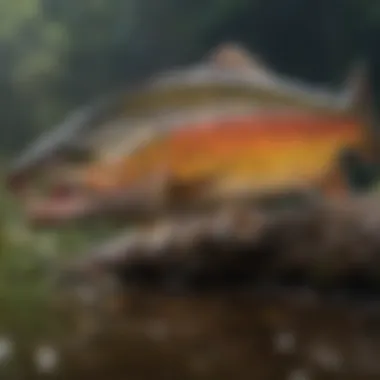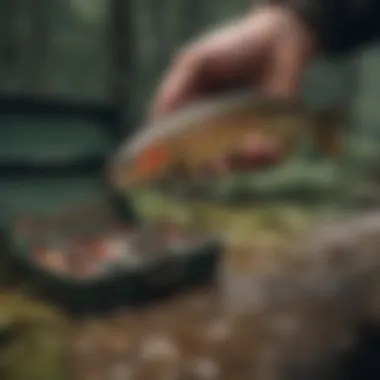Best Trout Bait: Comprehensive Guide to Optimal Choices


Intro
The pursuit of trout fishing goes beyond merely reeling in fish. It involves a deep understanding of both the environment and the feeding habits of various trout species. Knowing which bait to use can lead to more successful outings, yet this aspect often remains overlooked. Trout are sensitive to numerous factors, including water clarity, temperature, and seasonality, which in turn affect their feeding behavior. This guide aims to demystify the intricacies involved in selecting the best bait for trout fishing, providing insights for anglers at all skill levels.
Overview of the Topic
Understanding trout bait not only serves recreational interests but also connects to a broader ecological awareness regarding sustainable fishing practices. Trout play crucial roles in aquatic ecosystems as both predators and prey. Various species, like Rainbows and Brook Trout, prefer different habitats and food sources, making the choice of bait essential. The topic's significance is underscored by the recommendations given in organized guidelines and studies, which detail effective fishing practices.
Current Status and Challenges
The culture of trout fishing is underpinned by local regulations, which can differ by region. Among the current issues emerging in different waters are the overfishing and mismanagement of resources. Besides, the increasing presence of pollutants is threatening freshwater environments, indicating that maintaining balance is crucial not only for trout but for overall aquatic ecosystems as well.
Understanding Trout Habitats and Feeding Behavior
Recognizing trout habitats and their feeding behavior is crucial for any angler. It shapes how one chooses bait and informs fishing strategies. When attempted thoughtfully, it can lead to better success on the water. Trout prefer cold water, and their habitats alter based on species and local conditions.
Geographical Distribution of Trout Species
Trout live in various geographical areas, particularly in North America and Europe. Common species include the brook trout, brown trout, and rainbow trout.
- Brook Trout — Frequent in eastern North America, thriving in clear, cold streams.
- Brown Trout — Present in multiple continents, including North America, preferring cooler, oxygen-rich waters.
- Rainbow Trout — Found widely across North America, they adapt to different habitats more easily than the other species.
Different locations provide specific environment needs. Understanding where the trout species hang out helps in choosing the right fishing spot. With complete awareness of region-specific habits, anglers can make informed decisions.
Feeding Patterns and Preferences
Trout have distinct feeding habits influenced by factors like water temperature, time of day, and availability of food sources. They are opportunistic feeders, often consuming any movement they detect in the water. Their diet usually includes:
- Insects: Drosophila and other fly species are essential, particularly during hatching times.
- Small fish: Young fish and minnows often attract predatory behavior.
- Crustaceans: In some areas, trout consume crawfish and other small aquatic; these organisms form significant portions of their diet, depending on availability.
Trout patterns include specific times like dusk and dawn when they tend to forage more actively. Additionally, seasonal factors influence behavior. In cooler months, trout tend to seek deeper waters, decreasing surface feeding, while in warmer seasons, they often return to shallows to feed actively. Thus, thorough understanding of their feeding patterns is a cornerstone for cultivating effective fishing strategies.
The more one appreciates the feeding behavior of trout, the more strategic their fishing approach will be.
Types of Trout Bait
Trout fishing demands a strong understanding of the type of bait used. Using the right trout bait can be the difference between a successful day on the water and an unfruitful outing. From live to artificial options, each type of bait appeals to different trout species in their habitats. Choosing the proper bait not only increases the chances of catching trout but has distinct advantages regarding technique, location, and even personal preference. The following sections delve into the nuances of live and artificial bait options that resonate with trout fishing enthusiasts.
Live Bait Options
Using live bait is a common practice among anglers due to its natural-aquatic appeal to fish. Furthermore, this bait is often perceived as a more trustworthy option, effectively attracting trout when presenting it strategically.
Nightcrawlers
Nightcrawlers are famous among trout fishers because of their lively movement in water. This type of bait emits vibrations and tantalizing scents that act as powerful attractants for trout species looking to feed. One key characteristic of nightcrawlers is their availability and ease of use. Most fishing stores stock them, allowing for straightforward acquisition.
Nightcrawlers also present flexibility in rigging options. They can be threaded onto hooks or fished under a bobber. This versatility enhances their effectiveness across various water conditions. However, one might consider the disadvantage: they can sometimes attract unwanted species like panfish or sometimes not survive the entire span of a fishing session, making handling important. Keeping them fresh is essential for the best effect.
Minows
Minows are another highly valued live bait choice in trout fishing. These small fish offer an excellent mimicry of trout’s natural prey, making them exceptionally effective in most environments where trout reside. Their key characteristic lies in their realism. Since they are swimming naturally, they strongly appeal to predatory instincts in trout, igniting immediate interest.
However, minnows can be cumbersome to keep alive, needing aeration systems even while on the go. Proper storage is critical when transporting them to the fishing site. Despite these challenges, minows, when well-maintained, often result in significant catches, especially in lakes or streams rich in fish activity.
Crickets


Crickets represent yet another enticing live bait option that fishermen can leverage. Their inherent movement and loud chirping make for an attention-grabbing presentation that can lure trout to bite. A notable aspect of crickets is their sensitivity in various fishing conditions. Many veteran anglers affirm that crickets work particularly well when the water is warm.
One unique benefit is they can be fished near the surface, especially during casting, contrastingably deviating from the typical options like nightcrawlers that engage below. They also require slight handling and minimal rigging—available at various bait shops, making them an accessible option for fishermen. It is important, nonetheless, to source live crickets to capture the utmost effectiveness.
Artificial Bait Solutions
Artificial baits present numerous alternatives for targeting trout, especially when live bait availability suffers. These man-made adaptions provide dependable solutions. Additionally, they allow for strategic customization adhering to specific fishing techniques chosen by inputting relevant scent or color adjustments.
Jigs
Jigs are widely-used artificial lures incorporating necessity and technique seamlessly. Their distinct characteristic is a weighted head linked to a hook, meant to imitate struggling prey. Anglers favor jigs due to their versatile action; they can be dragged along the bottom or vertically suspended in the water column giving them appeal in several contexts.
Jigs can sometimes benefit from adding trailers to enhance their look and aroma, providing an even more potent attractant. Nonetheless, effective jigging requires moderte experience, as improper presentation yields few opportunities for catches. Their accessibility remains solid—amplifying appeal for novice participants.
Spoons
Spoons stand out in the artificial bait category as well. Their unique teardrop shape designed to spin in water mimics a distressed fish. Their shining surface also creates flash, capturing trout attention from a distance. Fishermen often prefer spoons during colder months or in deep waters, illustrating adaptability across environments.
Their special feature, offering both versatility in retrieves and depths fished, gives spoons a special edge. On the disadvantage side, choosing spoons should continually adapt with trail significance, yet once learned, some practitioners declare implementation a relative art in achieving success within current conditions.
Soft Plastics
Soft plastics have grown substantially in popularity among trout fishermen over recent years. This bait option presents legions of designs meant to glance at common reconstructs of local prey; worms, minnows, or crawfish. One primary appealing aspect to soft plastics revolves in their consistent modifying ease—a range of colors and shapes manifests purposeful assistance crafting to dynamic environments.
Nevertheless, maintaining realism during presentation translates critical to evaluations—anglers face higher effective chances when carefully managing their mechanisms. Thus, a certain level of experimentation may be needed to apprehend the finest possible condition for best outcomes.
By analyzing both live and artificial options in baiting tactics, the outlined choices give insight into suitability above encounter techniques tailored to specific situations. Readers must consider distinct factors translating into meaningful bite periods as they approach their local rivers or lakes.
Factors Influencing Bait Effectiveness
Understanding the various factors that influence bait effectiveness is crucial for successful trout fishing. Several elements can substantially affect the choice of bait, dictating what will entice a fish to bite. By paying attention to these factors, anglers can enhance their fishing experiences and increase their chances of success. This section delves into significant factors like water conditions and timing, which can markedly shift the behavior of trout regarding bait selection.
Water Temperature and Clarity
Water temperature plays a pivotal role in fish behavior, especially for trout. Different species have preferences for specific temperature ranges where their activity level improves. In general, trout are most comfortable in water that is between 50°F and 65°F (10°C to 18°C). If the water is too warm, they are more likely to be lethargic and less inclined to chase after bait. Conversely, when temperatures fall below 50°F, trouts may become more active, searching for food to build energy.
Clarity of the water also affects bait effectiveness. In clear water, trout are more likely to scrutinize potential food sources. Anglers should opt for natural-looking baits and subtle colors that blend into the surroundings. In contrast, murkier conditions call for brighter and louder baits that grab a fish's attention. Keep in mind that excess sediment or algae can lower the overall visibility. It's essential to observe local conditions before selecting your bait.
Time of Day and Seasonal Variations
Both time of day and the specific seasons can significantly influence bait choice and trout feeding behavior. Generally, trout are more active during early morning and late evening. The limited light during these periods prompts them to patrol the shallows, making it more likely that they will be tempted by bait. If you're aiming for maximum effectiveness, plan your trips for these vital hours whenever possible.
Seasons also dictate trout behavior. During spring, as water warms, trout become increasingly active after the long, cold winter months. Fall presents another prime fishing opportunity as fish prepare for winter by feeding more aggressively. Summer months recommend early outings. The midday heat tends to push trout deeper and into cooler waters, affecting how and where they respond to bait.
Consider using different bait types and colors throughout the day and seasons.
By understanding and adapting to these diverse factors, anglers can enhance their strategies, making more informed decisions about which bait to select. Tailoring your choice to fit both environmental conditions and time factors is a tested way to increase the likelihood of trout success.
Selecting the Right Bait for Specific Conditions
Choosing the appropriate bait for trout fishing is critical for success. Different species and environments require different bait types. Understanding these variations can significantly increase the chances of a fruitful fishing expedition. Specific conditions like water type and weather greatly influence fish behavior. A mismatch in bait can lead to wasted time and energy.
Freshwater vs Saltwater Trout
The variation in evironment between freshwater and saltwater trout is fundamental to selecting bait. Trout thrive in both settings, but their feeding habits and preferences greatly differ.
In freshwater rivers and lakes, trout commonly consume insects, small fish, and worms. Therefore, effective options include nightcrawlers, minnows, and various insects. For instance:


- Nightcrawlers can work exceptionally well due to their high protein content.
- Minnows serve as a natural bait that mimics the trout's typical forage.
- Insect larvae, like mayflies, are abundant in calming waters during the spring and summer and can be particularly alluring.
In contrast, saltwater trout might frequent more diverse habitats, often exhibiting different feeding behaviors. They may engage with a convincing form of artificial bait. This includes:
- Soft plastics that imitate local species of fish.
- Jigs can be useful because they mimic injured baitfish.
- Spoons also reflect light, triggering a natural curiosity in saltwater trout.
Understanding these differences can lead to productive fishing days regardless of the type of water one selects.
Choosing Bait Based on Weather Conditions
Weather holds a significant role in determining fish activity patterns. Variables like temperature, wind, and cloud cover influence trout behavior.
- Warm Days: At higher temperatures, fish often become more active and are willing to chase bait. Opt for fast-moving lures such as spoons, which easily attract attention.
- Cloudy or Rainy Weather: Fish tend to come closer to the surface, responding well to live bait. Nightcrawlers or crickets will entice trout effectively, proving superior during such conditions.
- Chilly Conditions: In colder weather, trout can become lethargic. Slow retrieving with jigs or using vibrantly colored soft plastics can encourage bites when conditions are less favorable.
Engaging with these considerations delivers strategic advantages that may elevate your experience and results on the water.
Bait Preparation Techniques
Bait preparation techniques play a significant role in successful trout fishing. Properly prepared bait can make the difference between a fruitful outing and a frustrating one. A keen understanding of how to handle and rig bait can enhance its appeal to trout. Attention to detail is essential in this aspect of fishing. It can increase the likelihood of attracting trout and ensuring they bite effectively.
Proper Storage and Handling
Correct storage and handling of bait are crucial for maintaining its effectiveness. Live bait, such as nightcrawlers and minnows, should be kept in conditions that mimic their natural habitat as closely as possible. Storing these baits in cool temperatures, with fresh air and moisture, preserves their vitality. Transition from vessel to hook can cause stress; therefore, minimizing time outside its environment enhances performance.
Some guidelines for storing live bait:
- Use aerated containers for minnows to keep them alive.
- Seal nightcrawlers in containers with ventilation. Avoid extremes in temperature.
- Check for dead bait daily, removing them to maintain hygiene.
Always keep artificial baits in their original packaging or in designated tackle boxes to prevent damage. This ensures they last longer and remain effective.
Rigging Live Bait on Hooks
Rigging live bait correctly is essential to engage trout. Improper rigging can lead to what is known as robbed bait—baits that do not achieve the desired catch due to careless handling. Understanding the hook's placement when rigging live bait will contribute significantly to its movement and overall effectiveness in water.
When working with live bait, consider these options:
- Through the Mouth and Out the Nose: For minnows, insert the hook through one side of its mouth and out through the nose. This gives the bait a natural movement that mimics how it swims.
- Behind the Dorsal Fin: Inserting the hook behind the dorsal fin provides stabilization and ensures the bait swims naturally without damaging the nervous system.
- For Worms (like Nightcrawlers): Space the hook through the worm at several points without completely impaling it. This allows the worm to move freely.
By following these steps and being precise leads to better results when fishing. Make adjustments based on conditions, size of trout, and preferred bait.
Fish with purpose. Proper handling and techniques can elevate your fishing experience, yielding more achievements on the water.
Legal and Ethical Considerations
The world of trout fishing invites many participants, from seasoned anglers to new leisure seekers. Ensuring that this pursuit remains enjoyable and ecologically viable can be achieved through a deep understanding of legal and ethical considerations. Salmonids, a family which includes trout, often reside in delicate ecosystems where their existence can be affected by overfishing or improper practices. Complying with local regulations helps ensure that these beautiful creatures thrive for future generations to enjoy.
Fishing Regulations
Fishing regulations are instituted by authority agencies to maintain healthy fish populations and protect the environment. Anglers must familiarize themselves with their local rules, which can vary notably between regions. Key regulations include:
- Licensing Requirements: Most regions require anglers to possess a valid fishing license, proving that the angler supports conservation efforts.
- Seasonal Restrictions: Some states impose specific fishing seasons to protect spawning populations. Anglers should be aware of these dates.
- Catch Limits: To sustain trout populations, land-use authorities often set limits on daily catches. Adhering to these limits is critical for conservation.
- Size Limits: In addition to daily catch limits, there may also be size limits to ensure that younger fish can reach maturity before being harvested.
It is advisable to regularly check regulations, as they can change. An up-to-date resource, such as the local fish and game department website, is an invaluable tool for anglers to carry in their tackle box.
Sustainable Bait Practices


Using sustainable bait practices benefits both trout populations and their habitats. Unsustainable practices can lead to depletion of resources and negatively impact the fragile environments their populations depend on.
Key strategies for sustainable bait selection include:
- Choosing Local Bait: Utilizing live baits from local ecosystems reduces the risk of spreading pathogens and preserving baitfish species.
- Avoiding Invasive Species: When selecting bait, anglers should steer clear of using species that could threaten local wildlife, such as certain minnows or worms.
- Proper Hooking Mechanics: Using barbless hooks not only makes it easier to release fish unharmed, but also reduces overall catch mortality.
- Minimizing Bait Waste: If possible, reduce waste by using only the amount of bait needed. When fishing with live bait, careful management and conservation can help avert negative ecological impacts.
Adopting sustainable practices contributes not just to personal fishing success, but to the broader environmental health of trout ecosystems. Ultimately, being a responsible fisherman aligns with enjoying the sport, as a healthy fish population leads to more captivating days on the water.
Choosing to fish responsibly helps conserve our environment. This is essential in maintaining the delicate balance of our fish populations.
Expert Tips for Trout Fishing Success
Fishing for trout requires more than just the right bait and gear. Expert tips can significantly enhance your chances of a successful catch. Within this section, we will discuss essential practices that every angler should consider. Utilizing nuances like scent enhancement and patience promotes a deeper connection to the sport. Understanding these principles can lead to gratifying experiences both on the water and in your harvest.
Using Scent and Flavor Enhancers
Scent and flavor enhancers can often tip the scales toward a fruitful fishing expedition. Trout rely heavily on their sense of smell, and introducing these enhancers can create a more enticing environment. Many products are on the market specifically designed for this purpose, often including scents like fish oil, garlic, or even specially formulated attractants.
- Apply scent to live bait by soaking it in the enhancer before your fishing trip.
- Add flavor gel to artificial lures to mimic the smells of baitfish or natural foods trout prefer.
- Don’t forget to reapply during fishing as scents can dissipate in the water.
The use of aroma substances can result in positive responses from trout that may not be as interested otherwise during the day. By making use of various enhancers, you create a competitive edge.
Patience and Observation Skills
Fishing requires the value of time along with skill. Factors determining trout behavior, from feeding patterns to environmental influences, necessitate observational skills. Taking the time to watch and learn from the surroundings can inform casting strategy and bait choices.
An effective approach involves:
- Spending Adequate Time: Often, fish may not bite immediately; waiting can support higher species activity.
- Monitoring Water Movements: Ripples and currents can indicate where fish might be feeding or resting.
- Listening to your Instincts: Experience leads to understanding where to concentrate casting without exhausting resources。
By developing patience and honing your ability to observe, you create more optimal conditions for fishing enthusiasts.
Remember, the best lessons come from patience and practice, not merely hooks and bait.
Epilogue
The conclusion of this guide highlights the significance of understanding the complexities of selecting the right trout bait. It summarizes the many options available and their respective advantages in varied fishing conditions. With both live and artificial baits discussed, anglers gain a comprehensive look at how each performs and suffices for distinct circumstances. Recognizing water temperature, clarity, and seasonal variations influences not just catch rates but also enjoyment during fishing trips.
In addition, this section considers the essential elements of responsible fishing. Each point discussed across the guide reaffirms that anglers contribute to conservation efforts by opting for sustainable bait practices. So, a deeper knowledge about trout bait can lead to better fishing experiences while keeping ecological balance.
Recap of Key Points
- Importance of Bait Choice:
- Factors Impacting Effectiveness:
- Tailoring Based on Conditions:
- Preparation Techniques:
- Legal and ethical implications:
- Types include live options like Nightcrawlers and Minows, and artificial styles like Jigs and Spoons.
- Water conditions and time of day could significantly affect bite rates.
- Freshwater, saltwater, and weather play key elements in bait selection.
- Correct storage and handling methods ensure bait stays effective.
- Need for understanding regional regulations for sustainable fishing practices.
Choosing the right bait enhances the fishing experience, while understanding its impact on nature is vital for responsible fishing habits.
Encouragement for Sustainable Practices
As anglers navigate through their pursuits, it is essential to carry a sustainable mindset. Ensuring that bait and fishing is carried out with minimal impact supports aquatic ecosystems. Practitioners should prioritize locals species of bait and avoid endangered options. Knowledge of fishing regulations guides safe and responsible practices.
Moreover, conservation education empowers fishermen at all levels. Use of native baits reduces ecological disturbances. By adopting prescribed limits on catch, anglers affirm their role in preserving trout populations and habitats.
Taking these measures can build a more robust commitment to conserving environments while achieving fulfilling fishing outings. In essence, with careful reflection on practices and a commitment to sustainability, trout fishing can continue to thrive for generations to come.



